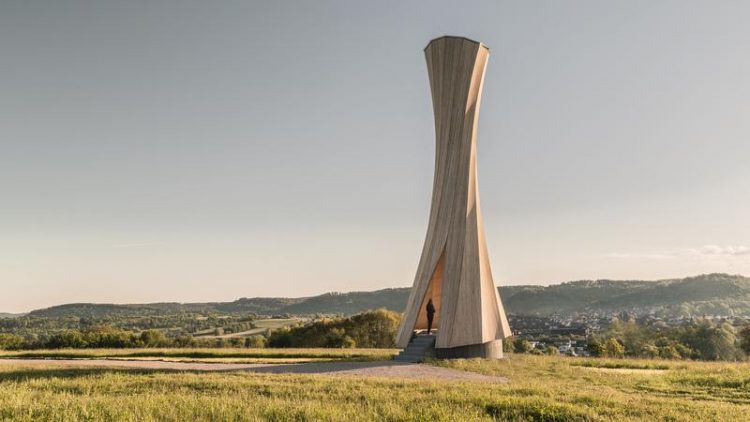Wood that Shapes Itself

Timber construction elements that are programmed shape themselves could give the timber construction additional momentum. Picture: Urbach Tower. University of Stuttgart, ICD/ITKE
Researchers from the University of Stuttgart, ETH Zurich and the Swiss Empa have presented a method with which wood panels themselves bend into a previously calculated shape in a controlled drying process without mechanical force.
The procedure, which contributed to the production of the Urbach Tower at the Remstal Garden Show near Stuttgart, was reported on by the renowned scientific journal Science Advances in its issue of 13 September 2019.
Self-forming mechanisms can be found in nature, for example in plants that change their shape automatically in a season to release their seeds. These changes occur without mechanical or electrical influence in both two and three-dimensional directions.
If, on the other hand, wood is to be deformed into curved or twisted structures, large and energy-intensive machines and formwork are required to press the components into the desired shape.
In the study published in Science Advances, researchers from the University of Stuttgart, ETH Zurich and Empa are now showing how structurally valuable curved geometries could be used in the future while avoiding complex and wastefully mechanical forming processes.
Together, they have developed an approach in which solid wood building components bend into a predefined shape without the application of external forces. For this purpose, the scientists used state-of-the-art modelling technologies to transfer the mechanisms known from nature, which are already used in small biomedical devices, to a large scale.
Curved wood parts up to five meters long were able to form themselves. “The ingenious use of self-forming mechanism enables us to give an ancient building material such as wood new functions” explains Dylan Wood, head of the Materials Programming Research Group at the Institute for Computational Design and Construction. “This opens up new avenues for sustainable yet high-performance construction, as well as revealing a new perspective on the digital design and fabrication of large parts with complex geometries.”
Employing Unwanted Behaviors
The self-forming process is based on the natural swelling and shrinking of wood depending on its moisture content: When damp wood dries, it contracts more perpendicularly to the grain direction than along the grain. Warping is usually undesirable. Researchers, however, make targeted use of this property by gluing two layers of wood together in such a way that their fibers are oriented differently.
The resulting wood parts called “Bilayers” have a two-layer structure forming the basic building block of the new method. When the moisture content of bilayer drops, one layer shrinks more than the other. Since the two layers are firmly glued together, the wood bends. Depending on the thickness of the layers, the orientation of the fibers and the moisture content, a computer model can now be used to calculate how the parts deforms during drying. When translated to the physical arrangement of specific elements within the parts the researchers call this process “wood programming”.
Curved components for roof constructions and walls have significantly a higher structural and material performance than flat parts and open up new architectural possibilities. Self-forming production now makes it possible to manufacture efficiently with a high degree of curvature in an adaptable process.
Prof. Achim Menges, Dylan Wood, University of Stuttgart, Institute for Computer-Based Design, Tel.: +49 (0)711/685 827 86, E-Mail: mail@icd.uni-stuttgart.de
Grönquistet P et al. Analysis of hygroscopic self-shaping wood at large scale for curved mass timber structures. Science Advances (2019),
https://advances.sciencemag.org/content/5/9/eaax1311 (Original Publication
https://icd.uni-stuttgart.de/?p=23336 (Video)
Media Contact
All latest news from the category: Architecture and Construction
Newest articles

Economies take off with new airports
A global study by an SUTD researcher in collaboration with scientists from Japan explores the economic benefits of airport investment in emerging economies using nighttime satellite imagery. Be it for…

CAR T–cell immunotherapy targets
Pan-cancer analysis uncovers a new class of promising CAR T–cell immunotherapy targets. Scientists at St. Jude Children’s Research Hospital found 156 potential CAR targets across the brain and solid tumors,…

Stony coral tissue loss disease
… is shifting the ecological balance of Caribbean reefs. The outbreak of a deadly disease called stony coral tissue loss disease is destroying susceptible species of coral in the Caribbean…





















